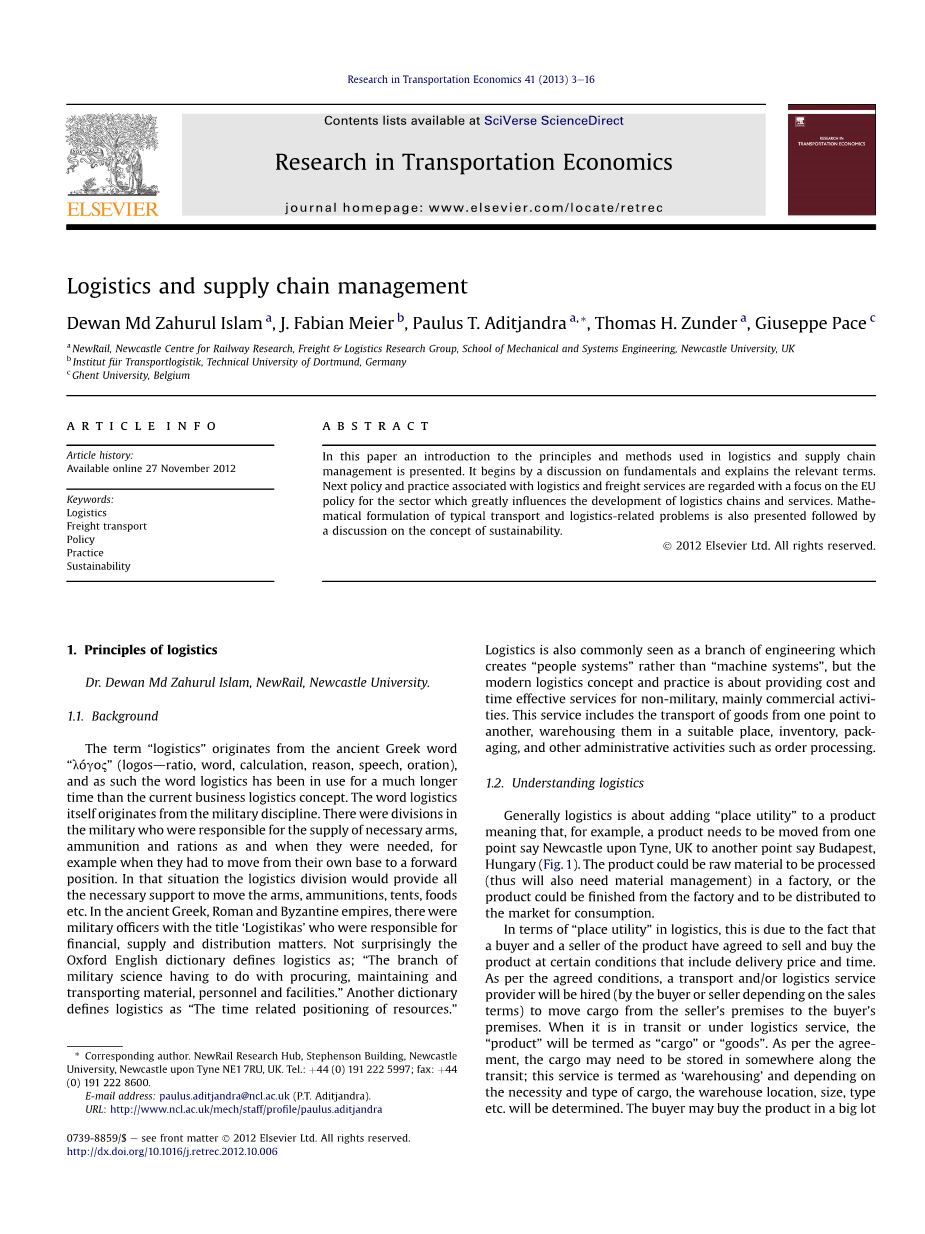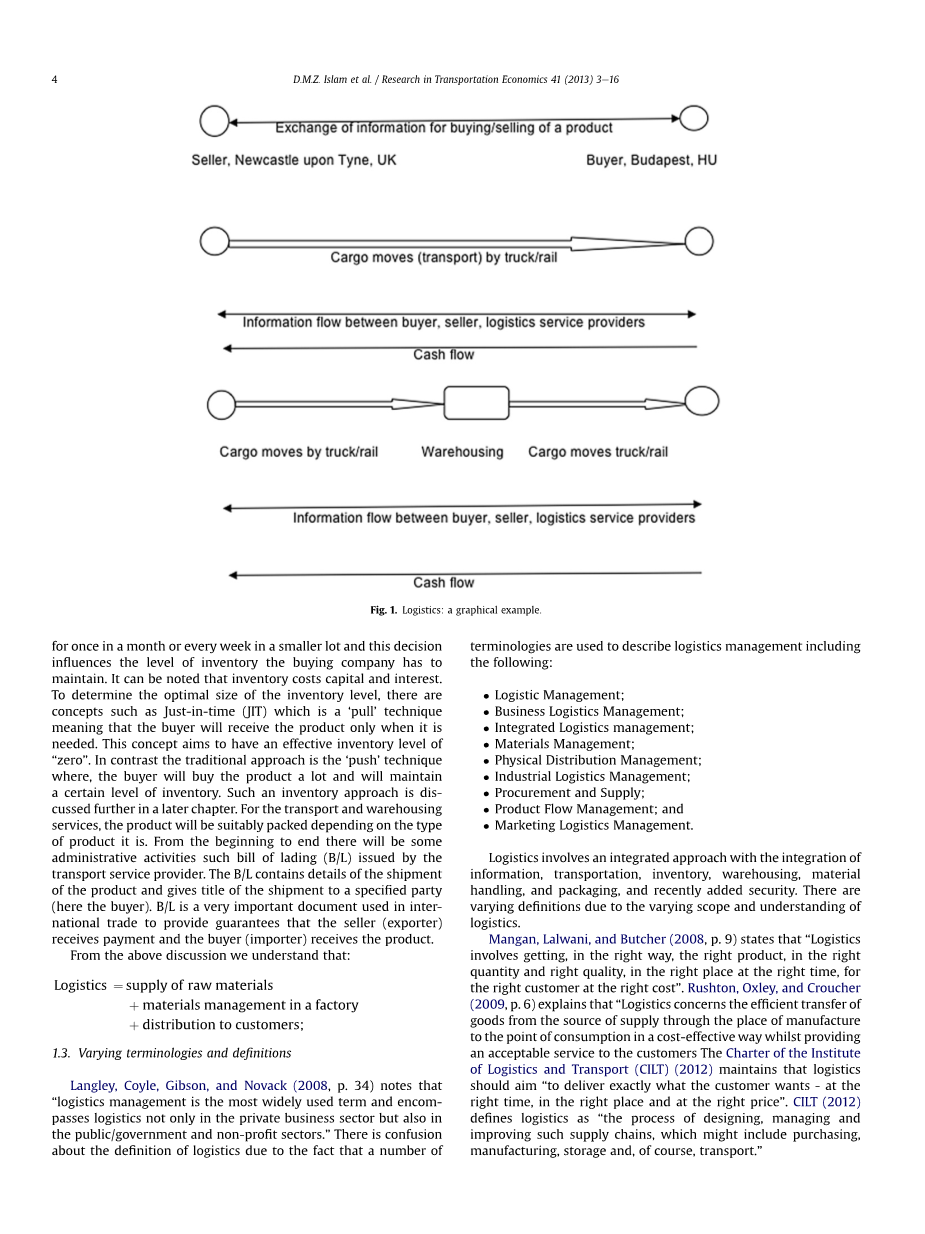

英语原文共 14 页,剩余内容已隐藏,支付完成后下载完整资料
原文
Logistics and supply chain management
1. Principles of logistics
Dr. Dewan Md Zahurul Islam, NewRail, Newcastle University.
1.1. Background
The term “logistics” originates from the ancient Greek word “loacute;go2” (logosdratio, word, calculation, reason, speech, oration), and as such the word logistics has been in use for a much longer time than the current business logistics concept. The word logistics itself originates from the military discipline. There were divisions in the military who were responsible for the supply of necessary arms, ammunition and rations as and when they were needed, for example when they had to move from their own base to a forward position. In that situation the logistics division would provide all the necessary support to move the arms, ammunitions, tents, foods etc. In the ancient Greek, Roman and Byzantine empires, there were military officers with the title lsquo;Logistikasrsquo; who were responsible for financial, supply and distribution matters. Not surprisingly the Oxford English dictionary defines logistics as; “The branch of military science having to do with procuring, maintaining and transporting material, personnel and facilities.” Another dictionary defines logistics as “The time related positioning of resources.” Logistics is also commonly seen as a branch of engineering which creates “people systems” rather than “machine systems”, but the modern logistics concept and practice is about providing cost and time effective services for non-military, mainly commercial activi- ties. This service includes the transport of goods from one point to another, warehousing them in a suitable place, inventory, pack- aging, and other administrative activities such as order processing.
1.2. Understanding logistics
Generally logistics is about adding “place utility” to a product meaning that, for example, a product needs to be moved from one point say Newcastle upon Tyne, UK to another point say Budapest, Hungary (Fig. 1). The product could be raw material to be processed (thus will also need material management) in a factory, or the product could be finished from the factory and to be distributed to the market for consumption.
In terms of “place utility” in logistics, this is due to the fact that a buyer and a seller of the product have agreed to sell and buy the product at certain conditions that include delivery price and time. As per the agreed conditions, a transport and/or logistics service provider will be hired (by the buyer or seller depending on the sales terms) to move cargo from the sellerrsquo;s premises to the buyerrsquo;s premises. When it is in transit or under logistics service, the “product” will be termed as “cargo” or “goods”. As per the agree- ment, the cargo may need to be stored in somewhere along the transit; this service is termed as lsquo;warehousingrsquo; and depending on the necessity and type of cargo, the warehouse location, size, type etc. will be determined. The buyer may buy the product in a big lot for once in a month or every week in a smaller lot and this decision influences the level of inventory the buying company has to maintain. It can be noted that inventory costs capital and interest. To determine the optimal size of the inventory level, there are concepts such as Just-in-time (JIT) which is a lsquo;pullrsquo; technique meaning that the buyer will receive the product only when it is needed. This concept aims to have an effective inventory level of “zero”. In contrast the traditional approach is the lsquo;pushrsquo;technique where, the buyer will buy the product a lot and will maintain a certain level of inventory. Such an inventory approach is dis- cussed further in a later chapter. For the transport and warehousing services, the product will be suitably packed depending on the type of product it is. From the beginning to end there will be some administrative activities such bill of lading (B/L) issued by the transport service provider. The B/L contains details of the shipment of the product and gives title of the shipment to a specified party (here the buyer). B/L is a very important document used in inter- national trade to provide guarantees that the seller (exporter) receives payment and the buyer (importer) receives the product.
From the above discussion we understand that:
Logistics frac14; supply of raw materials
thorn; materials management in a factory
thorn; distribution to customers;
Fig. 1. Logistics: a graphical example.
1.3. Varying terminologies and definitions
Langley, Coyle, Gibson, and Novack (2008, p. 34) notes that “logistics management is the most widely used term and encom- passes logistics not only in the private business sector but also in the public/government and non-profit sectors.” There is confusion about the definition of logistics due to the fact that a number of terminologies are used to describe logistics management including the following:
● Logistic Management;
● Business Logistics Management;
● Integrated Logistics management;
● Materials Management;
● Physical Distribution Management;
● Industrial Logistics Management;
● Procurement and Supply;
● Product Flow Management; and
● Marketing Logistics Management.
Logistics involves an integrated approach with the integration of information, transportation, inventory, warehousing, material handling, and packaging, and recently added security. There are varying definitions due to the varying scope and understanding of logistics.
Mangan, Lalwani,
剩余内容已隐藏,支付完成后下载完整资料
资料编号:[258307],资料为PDF文档或Word文档,PDF文档可免费转换为Word


